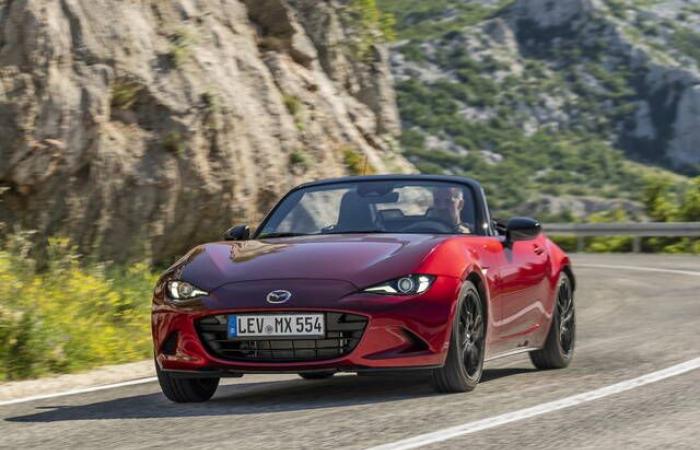Happy birthday!
35 years after the launch of the progenitor and ten years after that of the latest generation model, signed ND, the small spider Mazda MX-5 it is slightly updated in the compact and bold bodywork, in the multimedia system and in the equipment of safety systems and driving aids.
Unchanged range of engines: as well as with the 1.5 132 HP of the car in our test (which for €2,300 more can also be had in the RF version, with the sheet metal roof foldable into three parts instead of the canvas one) the Mazda MX-5 it’s also there with a more exuberant 2.0 (whose 52 HP more can be felt above all at low and medium revs). If it is the latter that you are thinking about, the good news is the introduction of a self-locking differential less abrupt in transferring the drive torque to the wheel with more grip on the asphalt (the countersteering to manage the power slides is a little less demanding); the less good one is that the car will remain on the list in Italy not for longbecause the company has no plans to update the 184 HP unit to Euro 6e regulations, which all newly registered petrol cars will have to comply with starting from 1 September 2024.
Little changes outside
The aesthetic changes made by the designers to the Mazda MX-5 they are minimal. In the front the grille changes slightly, which now integrates the radar sensor for electronic driving aids (among others, the lane keeping system makes its debut), and the LED daytime running lights, still made up of diodes but now incorporated into the headlights instead of in the air intakes on the sides of the bumper. BehindHowever, the headlights have changed, having a particular three-dimensional finish and LED direction indicators.
Now it has a bigger screen
In the cockpit of the Mazda MX-5 (all in all welcoming for the type of car, provided you are not taller than 185 cm) the main novelty is the multimedia system, which now has an 8.8″ screen (previously it was 7″) and includes wireless connection with Android Auto and Apple CarPlay; only in the latter case, however, is the display clickable (in any case, you can navigate between the various menus with the convenient wheel in the tunnel between the seats). The hands and numbers of the round instruments located behind the are also new, now easier to read steering wheel three spokes. The latter, although pleasant and comfortable to hold, does not have depth adjustment: those who are much taller or shorter than average, also due to the limited height range of the seat, may have some problems getting really comfortable.
Not very practical, but well made
Although all rigid, the plastics I am quality and well assembled; The storage compartments, however, are few and small: there are neither pockets in the doors nor a drawer in the dashboard, and in the well under the armrest there is no place even for a small smartphone; if you don’t want to keep everything in your pockets, the only solution is to open the small door in the wall behind the seats, which gives access to an unexpectedly deep compartment (two others, difficult to reach, are created in the same wall, behind the backrests). The trunk It has a capacity of just 130 litres and a rather irregular shape: to take advantage of the little space available, it is better to choose soft bags.
He knows how to entertain you
A new feature, starting from the intermediate Exclusive Line trim of the car in our test, is the driving mode that the house calls DSC Track: this is a slightly looser calibration than ESP, to be used on the track, as the name suggests: the electronic control intervenes later and only if it realizes that the driver is not reacting correctly (countersteering), giving the thrill of “controlled skid”. The more experienced, then, can choose to deactivate the stability control completely, relying on their driving sensitivity (and their reflexes). Having said that, even by pressing the accelerator pedal fully with the wheels turned, it is difficult to trigger losses of grip that are difficult to control; the thing to pay attention to, if anything, are the quicker changes of direction at high speeds, where the car, given the calibration rather soft of the suspension (surprisingly effective in “digesting” bumps and potholes), it tends to wobble a bit.
An engine worth listening to
Let it be steering be the exchange they bring joy to athletes. As for the first, of his own quick and precise, Mazda engineers have provided materials with a lower friction coefficient for the rack and different electronic management; the result is a slightly smoother command when “returning” the steering wheel after a sharp bend. The change, however, is a pleasant confirmation: the short stroke of the lever, the precision of the shifts and the spacing between the ratios, which favors brilliant driving, make the six-speed manual of the Mazda MX-5 one of the best on the market. And speaking of driving pleasurethanks to an additional hole made in the air filter box, the duct closed by a diaphragm that connects the intake manifold to the passenger compartment (present since the launch of the MX-5 ND) now makes the roar even more captivating of the 1.5, which, despite not being a “racing” engine, pushes with good verve even before the section of the rev counter in which it gives its best, i.e. from 5000 to over 7000 rpm.






